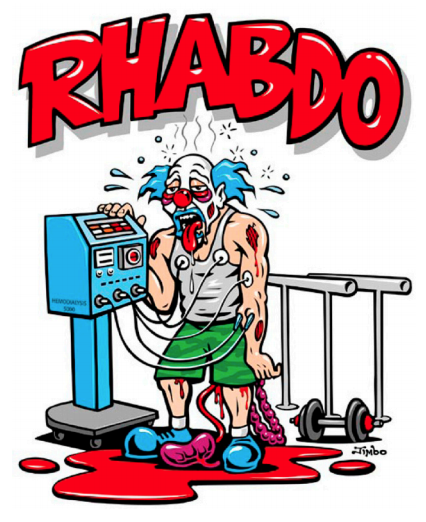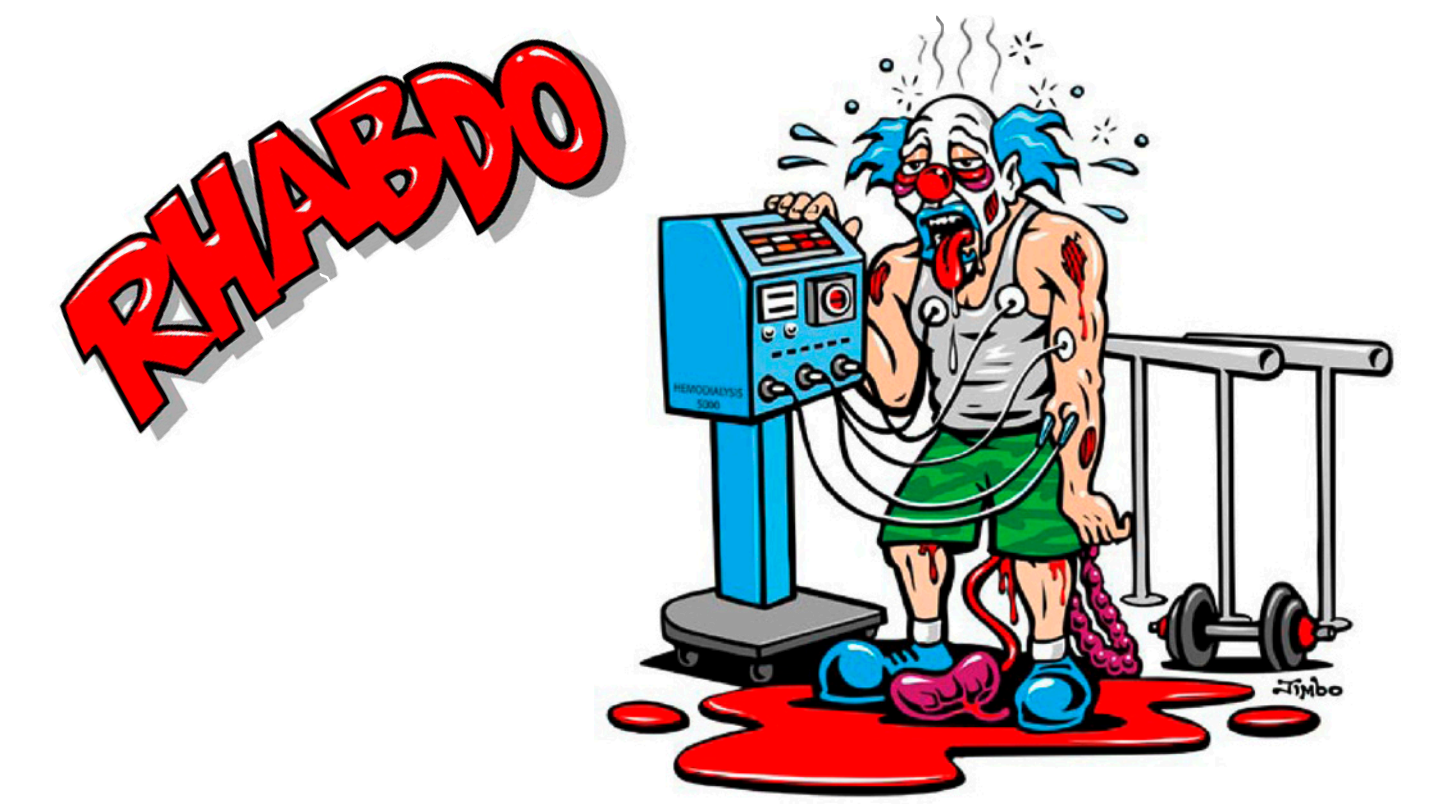We warned of rhabdomyolysis in a previous issue and return to the topic this month not only to repeat our warning but to share the lessons we’ve since learned about “exertional rhabdo.”
Before the first rhabdo case was brought to our attention, we regularly warned of CrossFit’s potency wherever we had the opportunity. In the January 2005 issue of the journal, we offered the following caution for newcomers tackling the WOD (Workout of the Day): “Countless bad-asses from sporting and special operations communities, long regarded as bulletproof, have been burned at the stake of ego and intensity.” As it turns out, the burning is rhabdo, and we now find ourselves obligated not just to explain CrossFit’s potency but to warn of its potential lethality.
We can dispense with much medical detail with a quick and easy description of rhabdomyolysis as a potentially lethal systemic meltdown initiated by the kidneys in response to the presence of shed muscle-fiber debris and exhaust in the bloodstream. There are several causes and types of rhabdo, classified by the underlying cause of muscle breakdown. With CrossFit we are dealing with what is known as exertional rhabdomyolysis. It can disable, maim and even kill.
To date we have seen five cases of exertional rhabdo associated with CrossFit workouts. Each case resulted in the hospitalization of the afflicted. The longest hospital stay was six days, the shortest two days. All have made full recoveries. The hardest hit was extremely sick, the least afflicted had no complaints other than soreness. All were extremely sore. Soreness doesn’t adequately explain the discomfort of rhabdo, however. The worst hit, a SWAT guy, recounts that six days of intravenous morphine drip barely touched the pain.
Victims include:
- Female college student, surfer, mountain biker, early twenties. Her second-ever CrossFit class in three days was a fast-moving, hard-hitting group workout that included high-rep assisted team pull-ups. She got sore, then sorer. Went to the E.R. Got admitted. Spent three days in the hospital. Didn’t “feel sick.”
- Dermatologist in his late forties. Avid tennis player. Recreationally active and competitive. His first CrossFit workout was on Monday, the second on Wednesday. Played several hours of tennis on Friday, Saturday and Sunday. Hospitalized on Monday. Chief complaint was soreness.
- Middle-aged fit SWAT guy famous for his exploits in a busy sheriff’s office. A CrossFitting friend took him through a “Helen”-like first exposure. Almost killed him—literally. Our first and worst bout of Rhabdo (and the one described in detail in issue 33 of the journal). Now an avid CrossFitter.
- Female collegiate softball pitcher. Challenged the manhood of her running-back boyfriend when he complained about CrossFit’s “Tabata This” workout. The running back gave the girlfriend the Pepsi challenge. She didn’t finish the workout and was hospitalized three days later for four days. Very sick girl.
- Special operations personnel. Ignored warnings to learn something about CrossFit before attending a three-day CF seminar. He put his bodybuilding and running regimen to the CrossFit test and suffered third and fourth quartile outputs on the first two of three days, was reduced to watching on day 3 (this probably saved his life) and in the hospital for days 4 through 8. Way too much CrossFit way too soon.
All five have made complete recoveries. The worst hit, the SWAT guy, is now a committed CrossFitter and can easily blast through workouts that once nearly killed him.
We’ve seen rhabdo in men and women, and in the young and middle-aged. They’ve each been and remain tough competitors and were, by popular and common standards, very fit. All were athletes. We have neither seen nor heard of a case of exertional rhabdo involving previously sedentary or inactive individuals.

The settings, circumstances, age, gender, background and trainers involved vary widely in our five cases but each victim was brand new to CrossFit. Each was wounded by a first or second workout. The victims of the one-two punch had their second workouts two days after their first.
We’ve not found a training regimen short of constantly varied functional movement executed at high intensity (CrossFit) that reduces the odds of crashing and burning—of potentially getting rhabdo—when first exposed to CrossFit. No experienced CrossFitter has had any rhabdo problems.
Our victims had typically previously experienced only low-power-output, low-intensity workouts. Regimens that separate strength training from cardio are almost always low-intensity regimens. Bodybuilding workouts coupled with long distance runs are not adequate preparation for sport, combat, emergency or CrossFit.
Since our first reporting on rhabdo five months ago, the National Strength and Conditioning Association (NSCA) has run articles in its magazine and presented experts on rhabdo at its events. The rhabdo described is generally correlated with exhaustion, dehydration, high humidity, high temperatures and long practices. Mental confusion and salt deposits are offered as signposts. This is not the rhabdo that we have witnessed.
The rhabdo we’ve seen has come from sessions of 20 minutes or less, with mild or low temperature and humidity. The victims were not excessively panting, straining, grunting or otherwise expressing abnormal discomfort from the workouts. The athletes who came down with rhabdo turned in marginal CrossFit performances and showed no signs of discomfort that were out of the ordinary. They left their workouts seemingly no worse off than anyone else. The environment and circumstances attributed to rhabdo in the sport and medical literature are so different from what we’ve experienced that we’ve termed the rhabdo we’ve seen as “cold rhabdo.”
From our perspective, it seems abundantly clear that these folks were exposed to too much work in too short a time. Their previous training—the kinds of programs offered in commercial gyms, fitness magazines, popular internet sites, the U.S. military (including special operations training) and police training agencies—all proved woefully inadequate at preparing them for sustained power output.
Elite CrossFitters are performing 18,000 foot-pounds of work per minute for three or four minutes (that’s nearly half of one horsepower!). This is what our top-tier athletes are doing in workouts like “Fran.” Without deliberately training for maximum expression of effective work against a wide-ranging time domain, it is virtually impossible to deliver power output as high as our athletes do. The training stimulus for developing power endurance that comes anywhere near that of our athletes is simply not there. CrossFit employs exercises, lines of action and programming templates that allow for expression of maximum work volume over a wide-ranging time domain. We don’t think anyone else is doing this anywhere.
Athletes from conventional training programs have found that, relative to CrossFit-trained athletes, a) they cannot maintain similarly high workloads, b) they are likely to suffer orthopedic trauma trying and c) they develop rhabdo at power output levels that are easily maintained by CrossFit regulars, including women, older athletes and children.
What the rhabdo outbreak teaches us is that CrossFitters are trained to perform more work, more effective work and more work more safely over a given time period than any other athletes. I think we can, have and will continue to prove this to all who would care to look, listen and think.
The “more work, more effective work, and safer work” model of CrossFit explains the weak performances and occasional rhabdo among seemingly fit athletes exposed to CrossFit, our dominance over traditional training protocols in clinical trials, and the utter and complete absence of challengers to CrossFit workout performances from non-CrossFitters in a nearly five-year-long, oft-repeated and very public call-out for fitter, tougher folks anywhere to show their stuff.
Nature, combat and emergency can demand high volumes of work performed quickly for success or for survival. Until others join CrossFit in preparing athletes for this reality, the exertional rhabdo problem will be ours to shoulder alone.
We have identified three key areas where we can minimize the exposure of unsuspecting souls to the realities of real-world physical challenge. Our rhabdo abatement program includes offering “elements” classes for newcomers, where the pace, and hence power output, is kept low while the athletes have time to learn new movements and gradually develop and adapt to higher power output. The mental model we’ve given our trainers is that of a longer on-ramp to the highway of full intensity for newcomers.
For our seminars we are issuing preseminar cautionary orders to participants recommending exposure to the functional movements before the seminar date. We are producing a pre-seminar video/DVD that will both warn of rhabdo and help participants prepare for the seminar. We’re also going to identify attendees uninitiated to CrossFit and personally counsel them to moderate their efforts and participation.
Finally, we are talking with our website designer about more visible warnings to catch any unsuspecting folks who may imprudently decide, despite our warnings, to tackle a workout full throttle and fully unprepared.
This article, by BSI’s co-founder, was originally published in The CrossFit Journal. While Greg Glassman no longer owns CrossFit Inc., his writings and ideas revolutionized the world of fitness, and are reproduced here.
Coach Glassman named his training methodology ‘CrossFit,’ which became a trademarked term owned by CrossFit Inc. In order to preserve his writings in their original form, references to ‘CrossFit’ remain in this article.

Greg Glassman founded CrossFit, a fitness revolution. Under Glassman’s leadership there were around 4 million CrossFitters, 300,000 CrossFit coaches and 15,000 physical locations, known as affiliates, where his prescribed methodology: constantly varied functional movements executed at high intensity, were practiced daily. CrossFit became known as the solution to the world’s greatest problem, chronic illness.
In 2002, he became the first person in exercise physiology to apply a scientific definition to the word fitness. As the son of an aerospace engineer, Glassman learned the principles of science at a young age. Through observations, experimentation, testing, and retesting, Glassman created a program that brought unprecedented results to his clients. He shared his methodology with the world through The CrossFit Journal and in-person seminars. Harvard Business School proclaimed that CrossFit was the world’s fastest growing business.
The business, which challenged conventional business models and financially upset the health and wellness industry, brought plenty of negative attention to Glassman and CrossFit. The company’s low carbohydrate nutrition prescription threatened the sugar industry and led to a series of lawsuits after a peer-reviewed journal falsified data claiming Glassman’s methodology caused injuries. A federal judge called it the biggest case of scientific misconduct and fraud she’d seen in all her years on the bench. After this experience Glassman developed a deep interest in the corruption of modern science for private interests. He launched CrossFit Health which mobilized 20,000 doctors who knew from their experiences with CrossFit that Glassman’s methodology prevented and cured chronic diseases. Glassman networked the doctors, exposed them to researchers in a variety of fields and encouraged them to work together and further support efforts to expose the problems in medicine and work together on preventative measures.
In 2020, Greg sold CrossFit and focused his attention on the broader issues in modern science. He’d learned from his experience in fitness that areas of study without definitions, without ways of measuring and replicating results are ripe for corruption and manipulation.
The Broken Science Initiative, aims to expose and equip anyone interested with the tools to protect themself from the ills of modern medicine and broken science at-large.
Support the Broken Science Initiative.
Subscribe today →
recent posts
Medical Society Webinar with David Wiss




